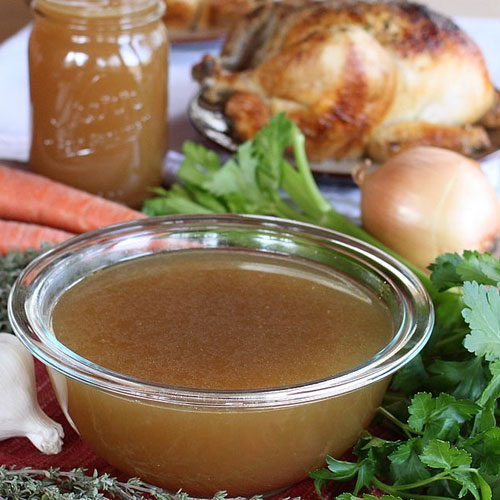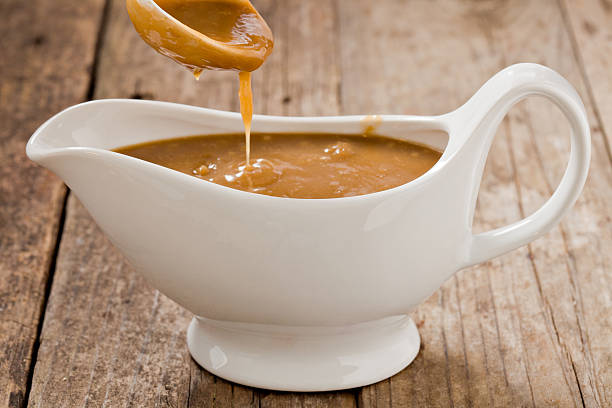I’ll admit that turkey gravy is never going to make it onto anybody’s list of superfoods. But, there is a little secret that you can use this Thanksgiving to make healthy turkey gravy (or at least a healthier turkey gravy) without sacrificing the amazing gravy flavor experience you expect.
Traditional turkey gravy is a combination of fat (from the roasted turkey pan drippings) mixed with a stock (vegetable, chicken or turkey) and a roux (white flour or cornstarch mixed with fat or water to thicken the gravy).
So, how can we turn this fat bomb into something that could possibly be described as healthy? When you make your stock with a nutrient dense and delicious bone broth, you add high quality nutrients to your gravy. In fact, the bone broth actually makes the gravy taste better. Personally, when I know there is some healthy bone broth in that yummy golden brown liquid, I feel better about ladling it all over my turkey, potatoes and stuffing. I bet you will too.
What is so healthy about bone broth? Here are some of its noteworthy benefits:
- It is rich in amino acids that are important for the health of your connective tissue (ligaments and joints).
- It builds collagen, which is one of the most important factors in keeping your skin looking young, minimizing wrinkles and reducing cellulite.
- It supports your immune system, helping you avoid or recover more quickly from colds and flus.
- It supports the health of your intestinal lining which is critical to maintaining good digestion and reducing the severity food allergies.
- It is rich in minerals that are critical to your health such as calcium, magnesium, phosphorous, silicon, sulphur and glucosamine. In addition, the bone broth makes it easy for your body to absorb these minerals.
- It boosts your body’s ability to detoxify the many toxins that we are commonly exposed to by supplying glutathione and sulphur.
How many calories are in turkey gravy, you may wonder? Isn’t that what Lot’s wife asked right before she turned to salt in the Old Testament? Folks, Thanksgiving is not the time to be counting calories! Remember, the happiness you experience when you gather with family and friends to share a humanely-raised Thanksgiving turkey dinner with gravy and all the fixings is good for the soul. That is the ultimate health food!
I hope my Healthy Turkey Gravy and Bone Broth recipes brings some extra enjoyment to your Thanksgiving celebration.

| Servings |
8+
|
- Bone broth or vegetable stock
- Turkey pan drippings
- Salt and pepper to taste
- ¼ cup organic flour or cornstarch for thickening the sauce with a roux*
Ingredients
|

|
- First prepare the bone broth or vegetable stock. If you don’t have bones, just use the vegetables recommended in the bone broth recipe and leave out the apple cider vinegar. You can prepare the broth the day before and have it ready in the refrigerator or just start it several hours before you put the turkey in the oven. If you are using bones in the broth, you will need a minimum of 4 hours to get the nutrients out of the bone. The longer it simmers, the better.
- In order to get turkey pan drippings, you need to start by cooking your turkey. Place the turkey in the oven for roasting. Pour 3-4 cups of white wine at the bottom of the turkey roasting pan so that you will have a generous amount of pan drippings. Cook your turkey according to your personal preference.
- When the turkey is done cooking, remove the turkey from the oven and set it aside to cool down and rest. Set the roasting pan with the turkey drippings on a medium-high heat on the stove-top. You may need to cover two burners due to the size of the roasting pan. Heat up the turkey drippings and add one cup of broth to the pan and stir. Be sure to scrape any turkey bits from the bottom of the roasting pan to get them into the gravy.
- Pour this gravy liquid into a large measuring cup or small bowl. If you have time, place in it in the refrigerator for 15-30 minutes to let the fat float to the top and harden. If you have less time you can just let the fat float to the top and spoon it out into a separate container. You can use this fat to make your roux (or you can discard it, if you want to make your roux with water).
- Now it is time to make the roux. If you are using the separated fat, put it in pan and heat it up. You should have about a quarter cup of fat to which you will add a quarter cup of flour or cornstarch. If you have less than a quarter cup of fat, you can add some broth get to that amount. Just be sure to keep the roux ratio of 1:1 of fat to flour or cornstarch. When the fat is hot, add the flour or cornstarch. Stir until smooth. Slowly add your gravy mixture to the roux and heat it up. Allow the liquid to thicken to desired consistency. If it is too thick, add more broth. Add salt and pepper to taste.
- If you are using water instead of fat for the roux, take two to four tablespoons of flour or cornstarch put it in a cup with the same amount of water. Stir strongly until the mixture is completely smooth. Slowly add the roux to the gravy and stir. Allow the gravy to thicken to the desired consistency. If you need more, make as much as you need to thicken the gravy. Add salt and pepper to taste.
* A roux is equal parts flour and fat cooked together and which is then used to thicken a sauce. I usually use water instead of fat for the roux. It is easier to make the roux with water but but it doesn’t blend as well and requires more stirring.

| Servings |
8+
|
- 2 lbs or more of bones from an organic, free-range animal (chicken, duck, turkey, beef or bison)
- 1 gallon filtered water
- 1 onion
- 2 carrots
- 2 stalks of celery
- 2 tablespoons of organic apple cider vinegar this helps to pull nutrients out of the bones and will not negatively impact the taste
- 1/2 bunch of parsely
- 2 bay leaves
- 1 tablespoon of sea salt
- 1 teaspoon of whole black pepperorns
- 2 cloves of garlic
Ingredients
|

|
- This step is optional but will add extra flavor. Pre-heat the oven to 375°F. Place the bones on a pan and cook in the oven until brown. Drain the fat and then transfer the bones to your stockpot.
- Since you are extracting the nutrients from the bones you want to be sure the animal was as healthy as possible. If using chicken or duck or turkey, you can also include the neck, feet and wings.
- Fill your stockpot with one gallon of cold filtered water. Add the bones and all of the vegetables and herbs.
- Turn the heat on and bring the water to just under a boil.
- Lower the heat and simmer the stockpot for 4 – 24 hours. A low heat with a long cooking time is necessary to extract the gelatin and other nutrients from the bones.
- While simmering discard any foam that rises to the top.
- When you are done, remove the pot from the stove and strain the vegetables and bones with a strainer or cheesecloth so that only the broth remains.
- Allow the broth to cool. If you store it in the refrigerator you should notice a layer of fat that will harden on the top. This layer protects the broth. You should only discard this layer when you are going to eat the broth.
- Use within 3-5 days or freeze for up to 3 months in freezer-safe containers.
